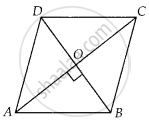Advertisements
Advertisements
Question
The lengths of the diagonals of a rhombus are 16 cm and 12 cm. Then, the length of the side of the rhombus is ______.
Options
9 cm
10 cm
8 cm
20 cm
Solution
The lengths of the diagonals of a rhombus are 16 cm and 12 cm. Then, the length of the side of the rhombus is 10 cm.
Explanation:
We know that,
A rhombus is a simple quadrilateral whose four sides are of same length and diagonals are perpendicular bisector of each other.
According the question, we get,
AC = 16 cm and BD = 12 cm
∠AOB = 90°
∵ AC and BD bisects each other
AO = `1/2` AC and BO = `1/2` BD
Then we get,
AO = 8 cm and BO = 6 cm
Now, In right angled ∆AOB
Using the Pythagoras theorem,
We have,
AB2 = AO2 + OB2
AB2 = 82 + 62
= 64 + 36
= 100
∴ AB = `sqrt(100)`
= 10 cm
We know that the four sides of a rhombus are equal.
Therefore, we get,
One side of rhombus = 10 cm.
APPEARS IN
RELATED QUESTIONS
All squares are ______.
Give two different example of a pair of similar figures.
Two triangles are similar, if their corresponding angles are .......... (proportional, equal)
Two triangles are similar, if their corresponding sides are .......... (proportional, equal)
Write the truth value (T/F) of each of the following statement
Any two similar figures are congruent.
For each of the following statements state whether true(T) or false (F)
Two circles with different radii are similar.
For each of the following statements state whether true(T) or false (F)
the polygon formed by joining the midpoints of the sides of a quadrilateral is a rhombus.
For each of the following statements state whether true(T) or false (F)
The sum of the squares on the sides of a rhombus is equal to the sum of the squares on its diagonals.
The symbol ~ is used to represent _________ triangles
ΔABC is an equilateral A of side a. Its area will be ______.
